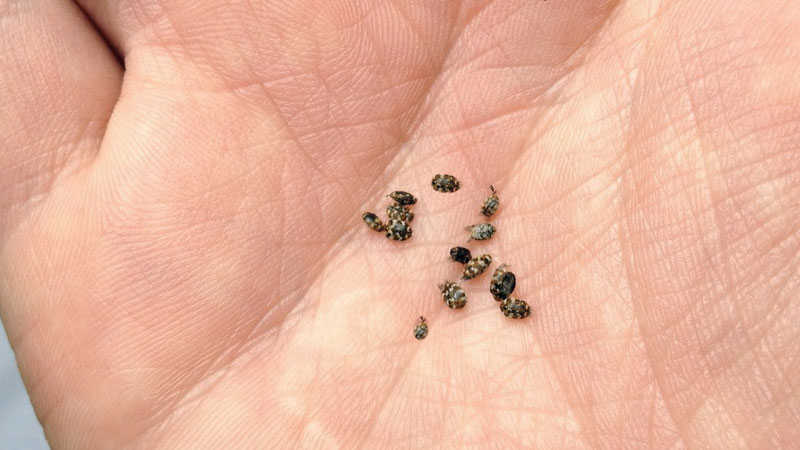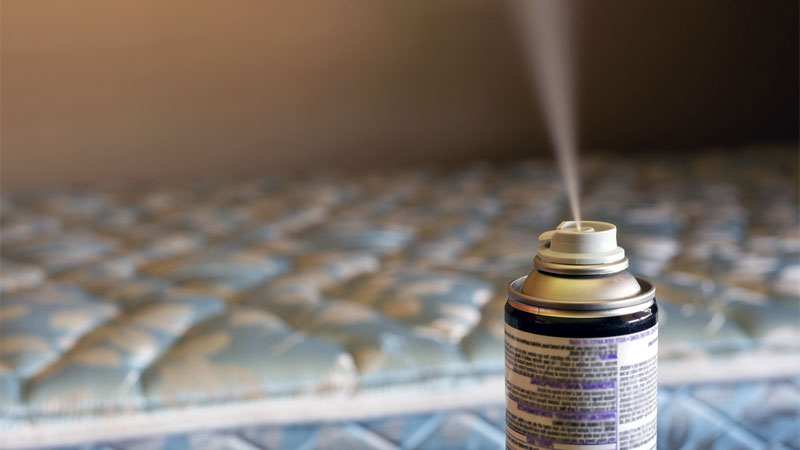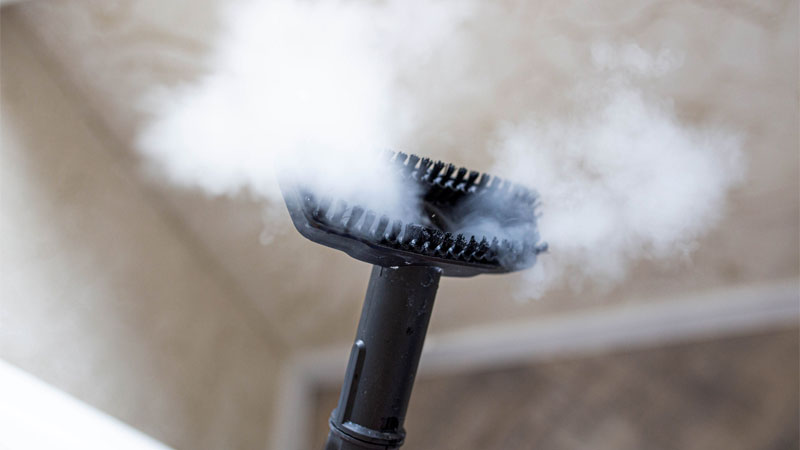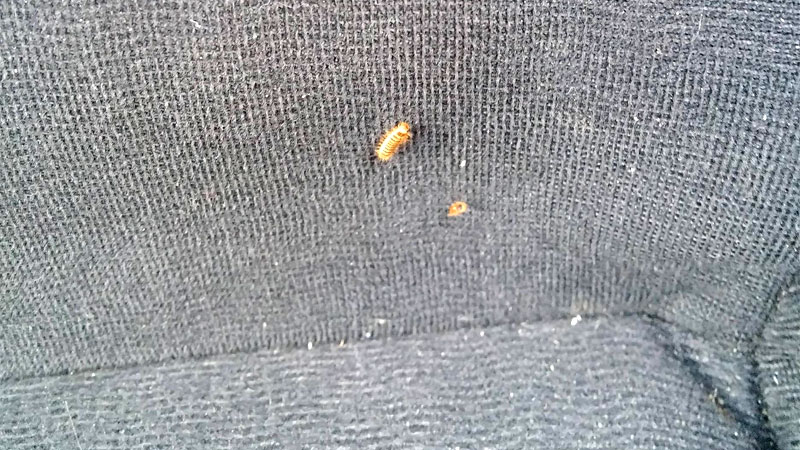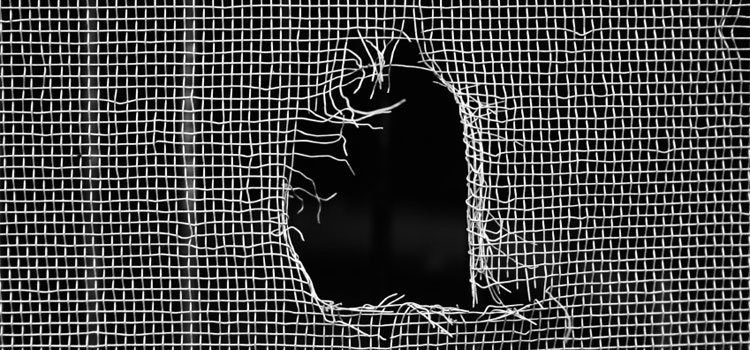There are a lot of critters that invade our homes, some of which get confused with other pests. One in particular is a tiny group of beetles that are often mistaken for roaches. These beetles are quite common, yet few people know their true identity beyond the nickname carpet beetle.
These critters are a strange lot, being completely harmless until they aren’t (unlike the aforementioned cockroach). So let’s take a deep dive into who they are, what they do, and how to get rid of carpet beetles when they become tiny monsters.
Getting to Know Carpet Beetles
Carpet beetles are a common household pest, perhaps almost as common as ants, rice beetles, bed bugs, fleas, palmetto bugs, silverfish, or stinkbugs (to name just a few frequent home invaders). Yet the average person knows less about these pests than any of the others.
It’s time to remedy this.
What Are Carpet Beetles, Really?
Most carpet beetles come from two genera: Attagenus (200 species) and Anthrenus. The number of species in the latter genus is unknown, as existing members are frequently being reclassified.
New species are discovered occasionally and the genus has been broken into several subgenera. What’s important to know is only 18 Anthrenus species are known to live in the US (which is a lot easier to deal with).
These little insects aren’t actually native to your carpet, however. Instead, they play an important role in the ecosystem, feeding off of pollen and dead insects, aiding in decomposition, and being generally useful little engines (of recycling). But once in the home, they become a threat to fabrics, food, and other goods.
The tiny, caterpillar-like bugs you might find crawling about in your carpet or in your bed are actually carpet beetle larvae and can be just as varied in appearance as the adults.
Here are five of the most common types of carpet beetles to attack US households:
Asian Carpet Beetle (Anthrenus coloratus)
The actual origin of this species is unknown. There are tiny populations found in India, Southeast Asia, Europe, and the Sudan. However, they’re widespread throughout the United States and Mexico. Its light markings often mean it gets confused with the common carpet beetle.
This species feeds primarily on fur and wool-based products. However, they have a special affinity for stuffed animals (no joke). They’re especially infamous for attacking taxidermy displays in museums.
Black Carpet Beetle (Attagenus unicolor)
This species was likely imported from Europe in the early 1800s. However, once in the New World, they quickly went from minor nuisance to major pests.
They’re highly destructive, targeting products containing keratin, cereals and grains, synthetic carpets, and wool-based products (their personal favorite). Black carpet beetles are dark brown to black, oval, and 1/8 to 3/16 inches long and hate humidity.
Common Carpet Beetle (Anthrenus scrophulariae)
Despite the name, these aren’t as common in the US as other species. They’re black, with patches of white and orange or reddish scales where the wing shells touch. However, these markings can rub off over time, making them a little harder to identify.
Their larvae attack mainly textiles, although the adults are harmless. These adult carpet beetles are a bit more rounded and measure a mere 1/10 to 1/6 inches long.
Furniture Carpet Beetle (Anthrenus flavipes)
Furniture carpet beetles are black with mottled patterns of brown, yellow, and white scales. These scales are more oval or round compared to other carpet beetles. Unfortunately, from a distance they’re easily be confused for other common species.
The furniture carpet beetle gets its name because the larvae frequently destroy upholstered furniture.
Unlike many carpet beetle species, these guys are affected by temperature but not humidity. In fact, adults of this species primarily feed on mold. This means you may have another reason to worry when you see this species in your home.
Varied Carpet Beetle (Anthrenus verbasci)
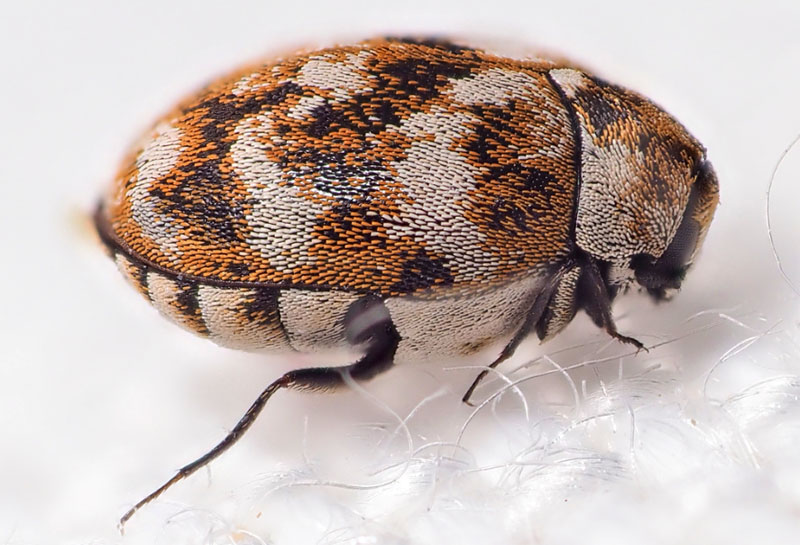
The varied carpet beetle measure only .07 to .14 inches long. Their round bodies covered in a rough pattern of brown, yellow, and white scales. Their larval stage is sometimes referred to as “woolly bear”.
This species is famous for being the first insect in which a circannual cycle was discovered. Unfortunately, they’re also well-known for attacking museum displays and having quite the appetite.
Adult insects of this species are relatively harmless, feeding on pollen and nectar. The woolly bears are a different story entirely. Beyond doing damage to fabrics, they also feed on pet hair, dead skin, insect carcasses, and even feathers.
Of course, there are many others you might encounter, such as fur beetles (Attagenus pellio). However, the five we’ve described tend to be the most common in American homes.
How Do Carpet Beetles Get In Your House?
Carpet beetles have a habit of simply wandering in through an open door or window, although they can get in through holes or cracks as well, most often in the spring. Thanks to their tiny size, they can often get in through spaces too small for most other insects.
They’ll often stick around if they find mess or a dusty environment because they see it as a perfect place for their young to feed. Unfortunately, once a carpet beetle infestation has started, it can be an uphill battle to completely eliminate them.
How Do You Find a Carpet Beetle Larvae Nest?
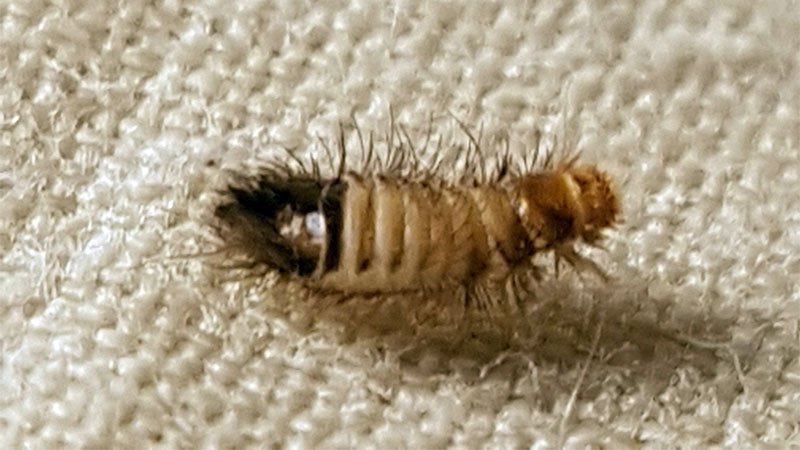
The adult stages of carpet beetles aren’t a direct threat, but when one decides to lay eggs, you’ve got an issue. Once the carpet beetle eggs hatch, it will take the larvae a little while to spread out, so it pays to search for these nests when you suspect the presence of carpet beetles.
Nests tend to be anywhere dark and sheltered, such as in cracks and crevasses, preferably close to a food source. There’s no physical structures to the nest outside of the egg clusters.
What Damage Do Carpet Beetles Do?
Carpet beetle larvae are the destructive ones, and they’ll feed off anything they think is waste. Depending on the species, this includes shed animal hair, plant-based fibers and foods (especially cereals, grains, and nuts – and even pet food), and sometimes synthetic fibers.
As a result, they can do extensive damage to textiles, upholstery, and even get into packaged goods. Regardless, they’re most infamous for munching on carpets and linens or chewing holes in clothing.
Can Carpet Beetles Bite?
Thankfully, no. Neither the larvae nor adult beetles are known to bite or sting and pose no direct disease risk for you or your pets.
However, their carpet munching can lead to bits of dead insects, dust, and other allergens. This may result in skin irritation or other reactions in sensitive people.
Can Carpet Beetles Live in Your Hair?
Yes, these pests can set up shop in your hair or your pet’s fur if you use essential oils as part of your hair care regimen. They might attempt to eat your hair once they’ve made it to your scalp, but pose no real risk (it might itch a bit, though).
You can easily evict them using a nit comb or kill them off with a hair dryer.
Can Carpet Beetles Crawl in Your Ears?
This scenario has often been used to scare people, although it’s not uncommon for bugs (including carpet beetles) to invade the ear canal. The good news is that, unlike Yeerks or Ceti eels (sci-fi fans will get it), carpet beetles won’t control you. However, they can still damage your eardrum if forced too deep.
If you suspect a carpet beetle got into your ear canal, use an ear syringe to inject (from the side, not directly into the canal) some warm water, baby oil, or hydrogen peroxide. This will kill the beetle.
You can then tilt your head over a bowl and gently flush the corpse out. Be sure to verify the corpse, and if you can’t get rid of the beetle, a trip to triage at the local ER may be necessary.
Read Also: Most Common Bug and Insect Phobias
Carpet Beetles vs Bed Bugs
A lot of pests resemble bed bugs, including carpet beetles. However, there are a few key differences. For example, bed bugs feed off of blood to reproduce. Carpet beetles won’t bite or sting, although sometimes the larvae cause an allergic reaction.
The other big difference is that bed bugs won’t chew holes in your carpets or clothing but do leave little black dots on your sheets that expand into tiny bloodstains if dampened.
Getting Rid of Carpet beetles
Carpet beetles aren’t especially difficult to eliminate, but their fuzzy larvae can do a lot of damage in a short amount of time. The two most common places they’ll infest are your home and car.
Here’s how to remove them from both, as well as how to prevent future infestations.
From Your Home
There are a few different tactics you can use to quickly eliminate carpet beetles and their larvae in the house. Here are some of the most effective (and cheap) ones.
Borax and DE
We talk a lot here about borax and food-grade diatomaceous earth (DE for short) because both are extremely effective and can be safe around people and pets if used responsibly. DE is generally non-toxic unless you try snorting the stuff. Meanwhile, borax is toxic if ingested but can safely be used as a common household chemical that won’t leave behind a residue.
For dealing with the carpet munchers, you’ll want to get the kids and pets out of the room. Simply sprinkle your chosen killer on the carpet or any upholstery and spread it evenly with a broom or similar tool. Allow it to sit for two to four hours, then come back in and vacuum thoroughly.
- Natural Product - Composed of 4lbs of 100% ground freshwater diatomaceous earth...
- OMRI Listed - Listed with the Organic Minerals Research Institute, a non-profit...
- Powder Duster Included - Powder duster in the bag for easy and efficient...
Fogging
While more of a last resort (or a product of laziness), insect foggers can make short work of carpet beetles and many other household pests. Before purchasing, be sure the fogger will work against carpet beetles and is a non-residue formula.
The latter is important because it’s annoying to scrub an entire room down and everything in it before people can enter.
Follow the instructions carefully when using one of these products. You should also purchase a fogger from a different brand at the same time. As the fogger won’t destroy the eggs, you’ll need to bomb a second time after a week or so. Using a different brand minimizes the risk of creating superbugs.
- NO NEED TO TURN OFF PILOT LIGHTS: Dry fog technology
- WHERE TO USE: Use in enclosed spaces such as apartments, attics, basements, boat...
- NON-STAINING: No messy residue
Surface Sanitation
In the kitchen and for non-upholstered furniture, you can use rubbing alcohol or a bleach solution of one part bleach to three parts water. Be sure the surface won’t be damaged by your weapon of choice before using.
By wiping the surfaces down with either of these, you’ll destroy any eggs and carpet beetles will avoid the area.
Vacuuming and Steam Cleaning
Dealing with carpet beetles sucks, so give them back a little of that feeling. Go over all of your carpets, upholstery, and anywhere you’ve seen them with a decent vacuum cleaner. This will get rid of most of them efficiently as long as you dispose of the bag or canister contents safely.
Once you’ve sucked up the critters, it’s time to make a second pass with a steam cleaner. These wonders not only get dirt the vacuum misses, the combination of heat and humidity will destroy the eggs and kill any carpet beetles that escaped the initial attack.
One of best investments you can make for your home is the Bissell Big Green carpet cleaner (or the smaller Little Green carpet cleaner). Not only will the heat kill carpet beetles and their larvae, you’ll remove anything that carpet beetles are attracted to and help prevent another infestation.
What (Usually) Doesn’t Work
It should be noted that some remedies out there do more harm than good, so a little caution is necessary. Here are three to avoid.
Essential Oils
We love essential oils, and normally they’re a great natural method for repelling pests. However, they can sometimes have the opposite effect on carpet beetles.
Depending on the oil you use and the species of carpet beetle, you can actually attract them, as we described regarding hair care products. Thus, it’s generally best to just avoid using essential oils around this particular type of pest.
The two exceptions seem to be peppermint oil and clove oil. These two are not only great repellents against many types of critter, they also have the ability to kill carpet beetle larvae on contact.
To use, add a few drops of one or both of these oils to a spray bottle. Make sure any surfaces you spray won’t be stained or damaged by the oils, then spray to kill on contact.
Mothballs
Mothballs are an old remedy that’s gone through some changes over the years. The simple fact of the matter is that they remain highly toxic (albeit less so than the old recipe) and aren’t nearly as effective as they claim to be.
It’s best to avoid this remedy altogether, as there are far better and safer options available for pretty much every pest.
Rubbing Alcohol on Textiles
Using rubbing alcohol or isopropyl alcohol on a carpet or other textiles can cause discoloration. Even worse, there’s some debate on whether rubbing alcohol is even effective against pests.
However, there’s an old secret among pet groomers for getting blood out of carpets: witch hazel. Witch hazel is usually dye-safe (although you’ll still want to test it to be sure), but is less effective.
Read Also: Does Rubbing Alcohol Kill Bed Bugs? (Here’s the Truth)
From Your Car
Outside of the home, the most common place to find carpet beetles is in your car. This tends to happen when they fly in through the window or an open door and discover you haven’t been cleaning.
It’s sometimes a bit more difficult to get them out of the car cabin than it is a room or house, but it can still be done. Try the following methods in order. Sometimes you can actually eliminate the problem without needing to advance to more drastic steps.
Step 1: Cleaning
Frequent cleaning can really help reduce he risk of an infestation, and this should be your first step. Remove all garbage from the cabin, as well as the floor mats. Wash the latter, then vacuum the carpet and upholstery thoroughly.
You may also wish to follow this up with a steam cleaning via a Little Green carpet cleaner or similar. In some cases, this is all you need, but if not, continue on.
Step 2: Solar Power
Try parking your car in a particularly sunny spot if its a warm day out. This will, of course, turn the cabin into an oven and can often fry adults, larvae, and eggs alike when the cabin gets hot enough and remains so for a few hours.
Just be warned, the cabin temperature must reach 120 degrees or hotter for a couple hours before this trick can do its job. Easy for those in Arizona; not-so-easy in northern states the majority of the year.
Step 3: Use Pesticides
The next line of attack is to use a pesticide. As usual, make sure it’s able to kill carpet beetles and follow all instructions carefully. You have a few options for this step.
Bug bombs are usually the final solution outside of calling in an exterminator, but they’re not as effective in cars. This is due to how vehicles aren’t built for insulation and can have a lot of little cracks and openings leading into the cabin.
Unfortunately, bug bombs need an enclosed space to really do their job, so while you’ll certainly kill a lot of carpet beetles using a bomb, you likely won’t get all of them.
Insecticidal powders can be sprinkled over all the upholstery and carpets where it will kill the critters on contact.
Commercial products such as Talstar or Suspend SC work best or you can go with the borax or DE method described above. You should leave these products sit for a minimum of a couple hours (or as described on the packaging), then give the entire cabin another vacuuming session.
Insecticidal sprays are a mixed bag even on the best of days. You can get residual sprays, but these are toxic, and you probably don’t want to be breathing in air containing the vapors. Non-residual sprays are safer to use, but they only kill on contact, meaning they’re largely ineffective when used in a cramped space such as a car’s cabin.
Ortho Home Defense Max is one of the few products that does a fairly good job on carpet beetles.
Step 4: Professional Intervention
Your car has a lot of little hiding spaces that can make it difficult for even the best effort to completely eliminate carpet beetles. If you’ve tried both of the above steps and still have a problem, it’s time to call in the pros.
Fumigating a car is a lot less expensive than a room or house, although it’s hardly free either. The good news is that a pest control company charges less than you’ll pay to have the cabin completely reupholstered.
A Note on Carpet Beetles and Gardens

Some species of carpet beetle are beneficial, but others are said to wreak havoc in the garden. In the process of feeding off of insect remains and flower pollen, a select few species have been blamed for chewing up light colored flowers or attacking grain and cereal plants or cotton crops. They’re also known to breed in the nests of sparrows and other birds.
Dealing with them in the garden can be annoying, but in most cases, the damage being done is actually at the maw of a different pest entirely. Be sure they’re the cause of any issues (hint: they almost never are), then use a neem soil soak or other natural solutions to deal with them if need be.
Carpet Beetle Prevention
Finally, let’s look at ways to keep carpet beetles from invading in the first place.
Seal Entry Points
As always, identifying and sealing entry points should be your first priority. Not only does this keep unwanted pests out of your home (garage, shed, etc.), it can also reduce your HVAC bills significantly.
Make sure all window and door frames are properly caulked. Patch up any cracks or holes in masonry, woodwork, or siding. Screen in vents and make sure any window or door screens are free of tears. Finally, make sure you never leave a door or window open unless it has a screen installed.
Encourage Garden Pals
While they’re not a threat to the garden, you can keep the carpet beetle population down through companion planting. Alliums and marigolds are particularly useful, as they repel a lot of common plant pests, look good, and attract pollinators.
More importantly, they can encourage natural predators such as ladybugs and parasitoid wasps which will prey upon carpet beetles and their larvae. The less you have in the yard or garden, the less likely one will get into your home.
Clean, Clean, Clean!
This cannot be stressed enough when it comes to pest control, but the best thing you can do is to keep things clean. Regular vacuuming (and occasional steam carpet cleaning) will ensure there are no tasty morsels and could potentially nab invaders before they have the chance to reproduce.
Keep perishables in airtight containers and clean up any spills promptly. Regularly sanitize counters with Chlorox wipes or similar disinfecting products to ensure there’s no trace of sugars or proteins (and it will get rid of some common contaminants to boot!), which might attract pests.
Clothes Care
You’ll also want to regularly wash clothes, linens, and other textiles. Dry cleaning is always a great option, as is ironing. Add some cedar blocks to your closet when putting linens away to repel a wide range of critters.
Always keep dirty clothes in a sealable hamper and be sure to fold and store clothes as soon as you wash them.
Consider Using Synthetics
Finally, while not guaranteed to work, most carpet beetle species are far less likely to munch on synthetic fibers than natural fibers. Thus, by using synthetics, you can reduce the risk of attracting these tiny terrors (and will suffer less damage if they do show up).
- How to Get Rid of Hawks - March 8, 2024
- How to Get Rid of Pill Bugs (Rolly Pollies) - March 1, 2024
- How to Get Rid of Groundhogs (Woodchucks) - February 5, 2024

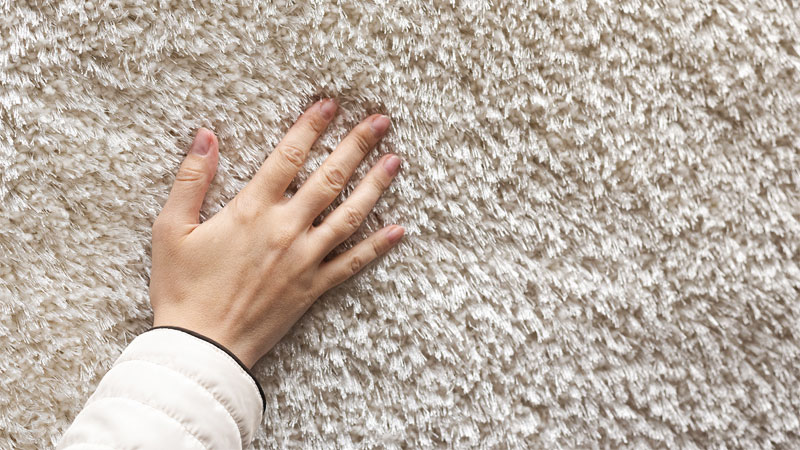
 Just tell me how to get rid of ’em.
Just tell me how to get rid of ’em.